Crisis Management Plan: Analysis of the Clarksville Tornado Case Study
VerifiedAdded on 2022/11/03
|8
|1564
|325
Report
AI Summary
This report presents a crisis management plan in response to the 1999 Clarksville, Tennessee tornado, analyzing the disaster's impact and outlining a comprehensive response strategy. The plan addresses the immediate aftermath, including loss of life, homelessness, and infrastructure damage, and proposes a collaborative team of six members to provide aid, focusing on resource allocation, engineering support, food distribution, and medical assistance. The report emphasizes the importance of social development theory in addressing the psychological trauma, addiction, and mental health challenges faced by the affected community. It also highlights ethical and multicultural considerations for counselors, including awareness of cultural values, client diversity, and culturally appropriate intervention strategies. References to relevant literature, including studies on extratropical storms, disaster relief, and mental health, are provided to support the plan's recommendations. The report concludes with a discussion of long-term recovery efforts, including the restoration of farmland, provision of financial aid, and access to mental health services.
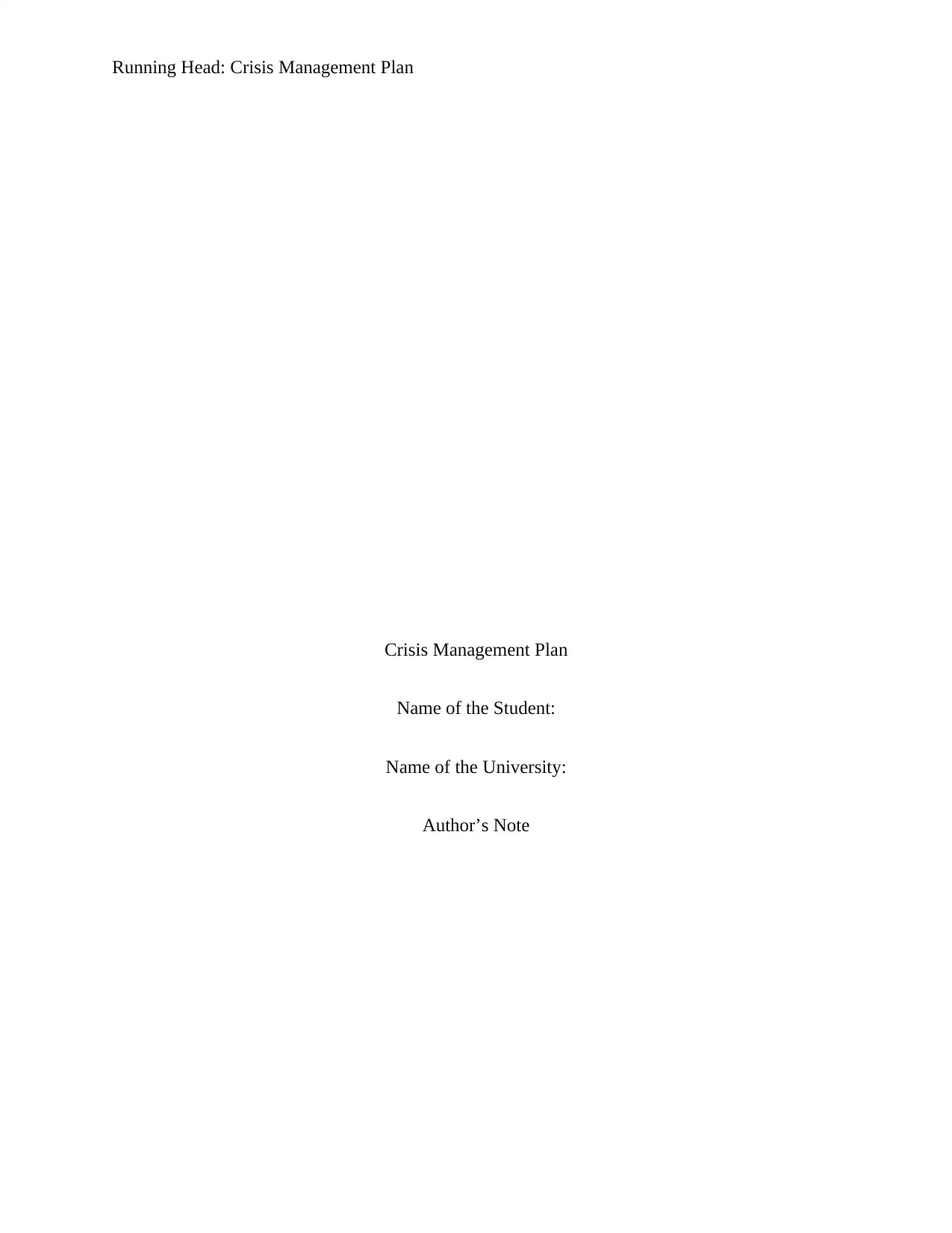
Running Head: Crisis Management Plan
Crisis Management Plan
Name of the Student:
Name of the University:
Author’s Note
Crisis Management Plan
Name of the Student:
Name of the University:
Author’s Note
Paraphrase This Document
Need a fresh take? Get an instant paraphrase of this document with our AI Paraphraser
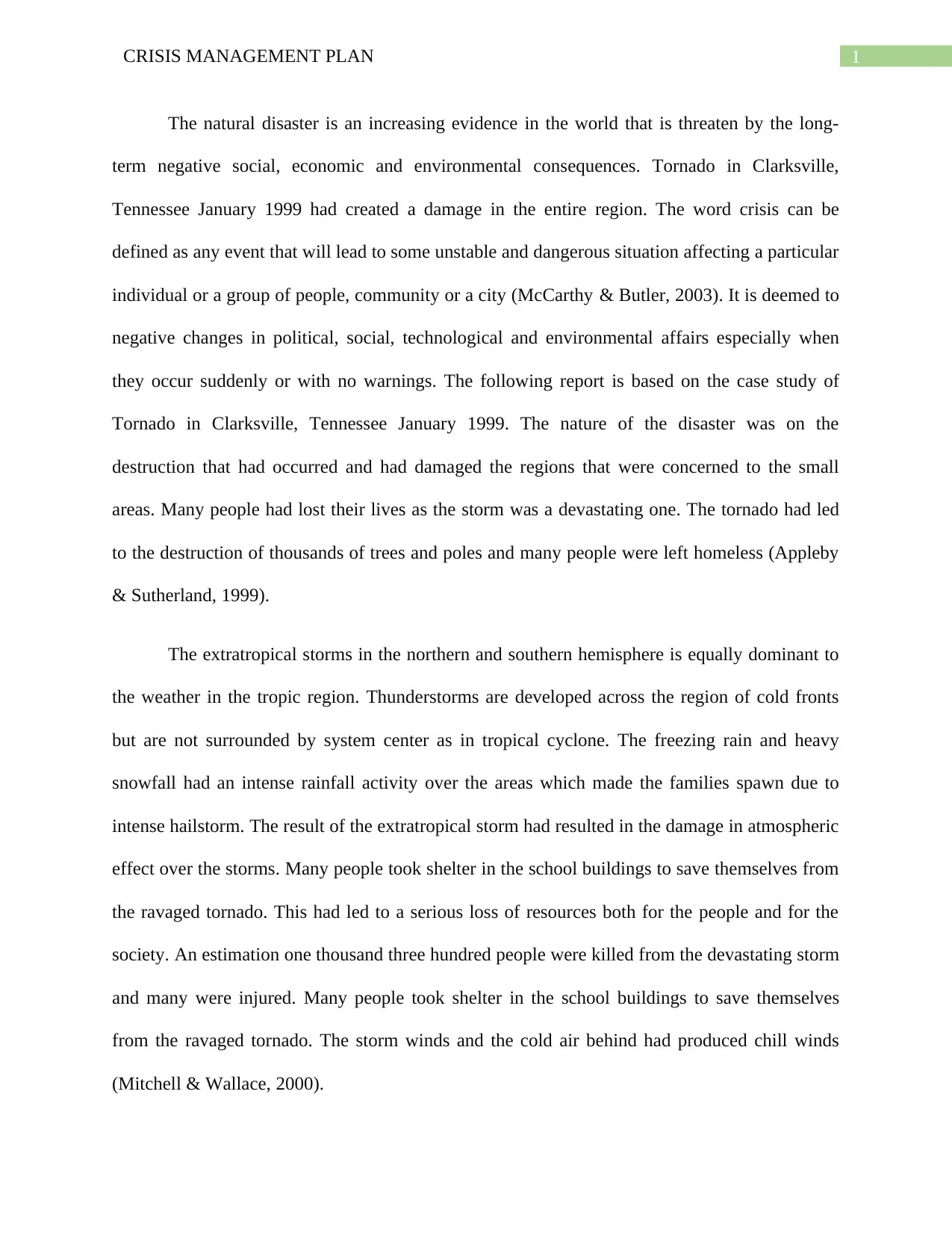
1CRISIS MANAGEMENT PLAN
The natural disaster is an increasing evidence in the world that is threaten by the long-
term negative social, economic and environmental consequences. Tornado in Clarksville,
Tennessee January 1999 had created a damage in the entire region. The word crisis can be
defined as any event that will lead to some unstable and dangerous situation affecting a particular
individual or a group of people, community or a city (McCarthy & Butler, 2003). It is deemed to
negative changes in political, social, technological and environmental affairs especially when
they occur suddenly or with no warnings. The following report is based on the case study of
Tornado in Clarksville, Tennessee January 1999. The nature of the disaster was on the
destruction that had occurred and had damaged the regions that were concerned to the small
areas. Many people had lost their lives as the storm was a devastating one. The tornado had led
to the destruction of thousands of trees and poles and many people were left homeless (Appleby
& Sutherland, 1999).
The extratropical storms in the northern and southern hemisphere is equally dominant to
the weather in the tropic region. Thunderstorms are developed across the region of cold fronts
but are not surrounded by system center as in tropical cyclone. The freezing rain and heavy
snowfall had an intense rainfall activity over the areas which made the families spawn due to
intense hailstorm. The result of the extratropical storm had resulted in the damage in atmospheric
effect over the storms. Many people took shelter in the school buildings to save themselves from
the ravaged tornado. This had led to a serious loss of resources both for the people and for the
society. An estimation one thousand three hundred people were killed from the devastating storm
and many were injured. Many people took shelter in the school buildings to save themselves
from the ravaged tornado. The storm winds and the cold air behind had produced chill winds
(Mitchell & Wallace, 2000).
The natural disaster is an increasing evidence in the world that is threaten by the long-
term negative social, economic and environmental consequences. Tornado in Clarksville,
Tennessee January 1999 had created a damage in the entire region. The word crisis can be
defined as any event that will lead to some unstable and dangerous situation affecting a particular
individual or a group of people, community or a city (McCarthy & Butler, 2003). It is deemed to
negative changes in political, social, technological and environmental affairs especially when
they occur suddenly or with no warnings. The following report is based on the case study of
Tornado in Clarksville, Tennessee January 1999. The nature of the disaster was on the
destruction that had occurred and had damaged the regions that were concerned to the small
areas. Many people had lost their lives as the storm was a devastating one. The tornado had led
to the destruction of thousands of trees and poles and many people were left homeless (Appleby
& Sutherland, 1999).
The extratropical storms in the northern and southern hemisphere is equally dominant to
the weather in the tropic region. Thunderstorms are developed across the region of cold fronts
but are not surrounded by system center as in tropical cyclone. The freezing rain and heavy
snowfall had an intense rainfall activity over the areas which made the families spawn due to
intense hailstorm. The result of the extratropical storm had resulted in the damage in atmospheric
effect over the storms. Many people took shelter in the school buildings to save themselves from
the ravaged tornado. This had led to a serious loss of resources both for the people and for the
society. An estimation one thousand three hundred people were killed from the devastating storm
and many were injured. Many people took shelter in the school buildings to save themselves
from the ravaged tornado. The storm winds and the cold air behind had produced chill winds
(Mitchell & Wallace, 2000).
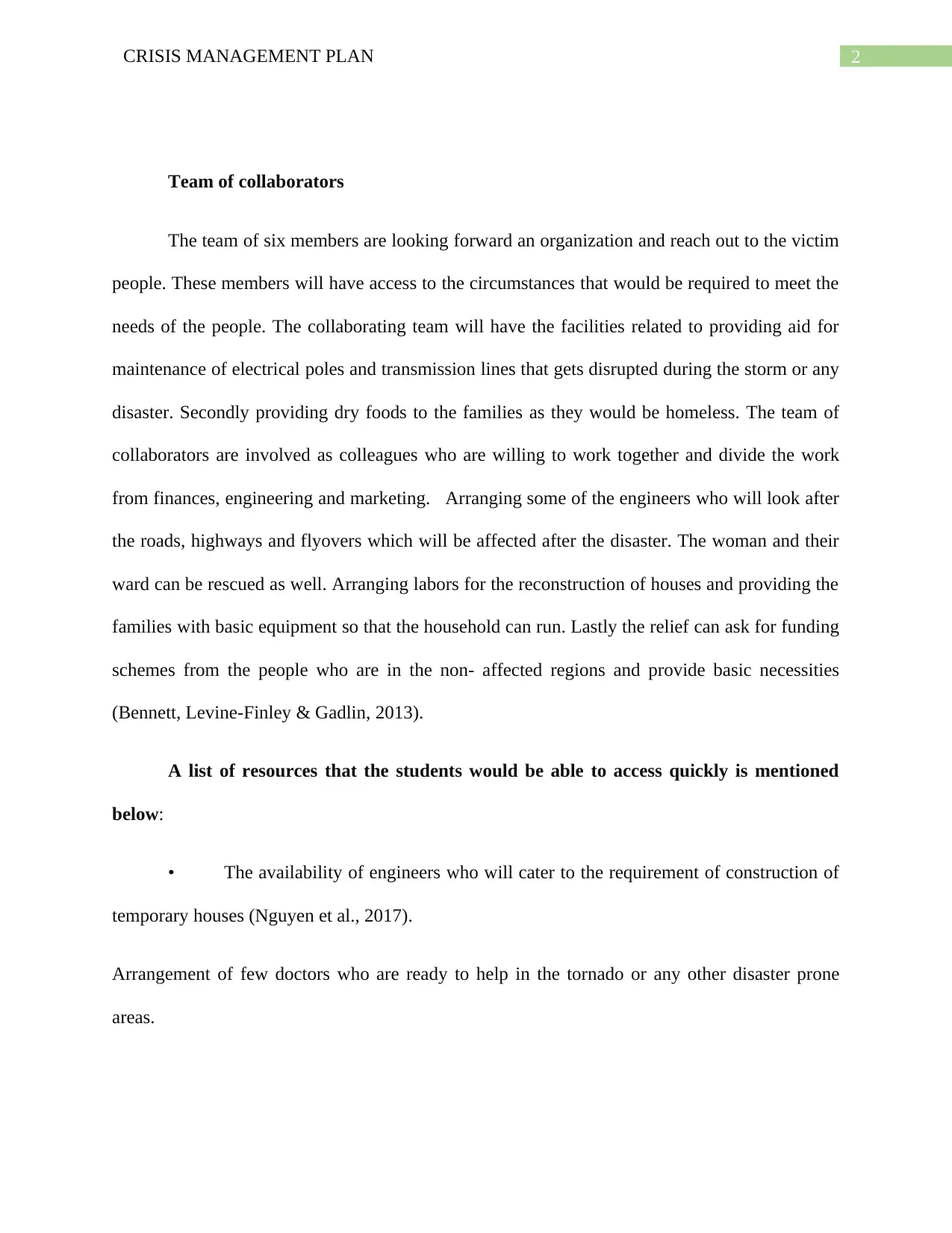
2CRISIS MANAGEMENT PLAN
Team of collaborators
The team of six members are looking forward an organization and reach out to the victim
people. These members will have access to the circumstances that would be required to meet the
needs of the people. The collaborating team will have the facilities related to providing aid for
maintenance of electrical poles and transmission lines that gets disrupted during the storm or any
disaster. Secondly providing dry foods to the families as they would be homeless. The team of
collaborators are involved as colleagues who are willing to work together and divide the work
from finances, engineering and marketing. Arranging some of the engineers who will look after
the roads, highways and flyovers which will be affected after the disaster. The woman and their
ward can be rescued as well. Arranging labors for the reconstruction of houses and providing the
families with basic equipment so that the household can run. Lastly the relief can ask for funding
schemes from the people who are in the non- affected regions and provide basic necessities
(Bennett, Levine-Finley & Gadlin, 2013).
A list of resources that the students would be able to access quickly is mentioned
below:
• The availability of engineers who will cater to the requirement of construction of
temporary houses (Nguyen et al., 2017).
Arrangement of few doctors who are ready to help in the tornado or any other disaster prone
areas.
Team of collaborators
The team of six members are looking forward an organization and reach out to the victim
people. These members will have access to the circumstances that would be required to meet the
needs of the people. The collaborating team will have the facilities related to providing aid for
maintenance of electrical poles and transmission lines that gets disrupted during the storm or any
disaster. Secondly providing dry foods to the families as they would be homeless. The team of
collaborators are involved as colleagues who are willing to work together and divide the work
from finances, engineering and marketing. Arranging some of the engineers who will look after
the roads, highways and flyovers which will be affected after the disaster. The woman and their
ward can be rescued as well. Arranging labors for the reconstruction of houses and providing the
families with basic equipment so that the household can run. Lastly the relief can ask for funding
schemes from the people who are in the non- affected regions and provide basic necessities
(Bennett, Levine-Finley & Gadlin, 2013).
A list of resources that the students would be able to access quickly is mentioned
below:
• The availability of engineers who will cater to the requirement of construction of
temporary houses (Nguyen et al., 2017).
Arrangement of few doctors who are ready to help in the tornado or any other disaster prone
areas.
⊘ This is a preview!⊘
Do you want full access?
Subscribe today to unlock all pages.

Trusted by 1+ million students worldwide
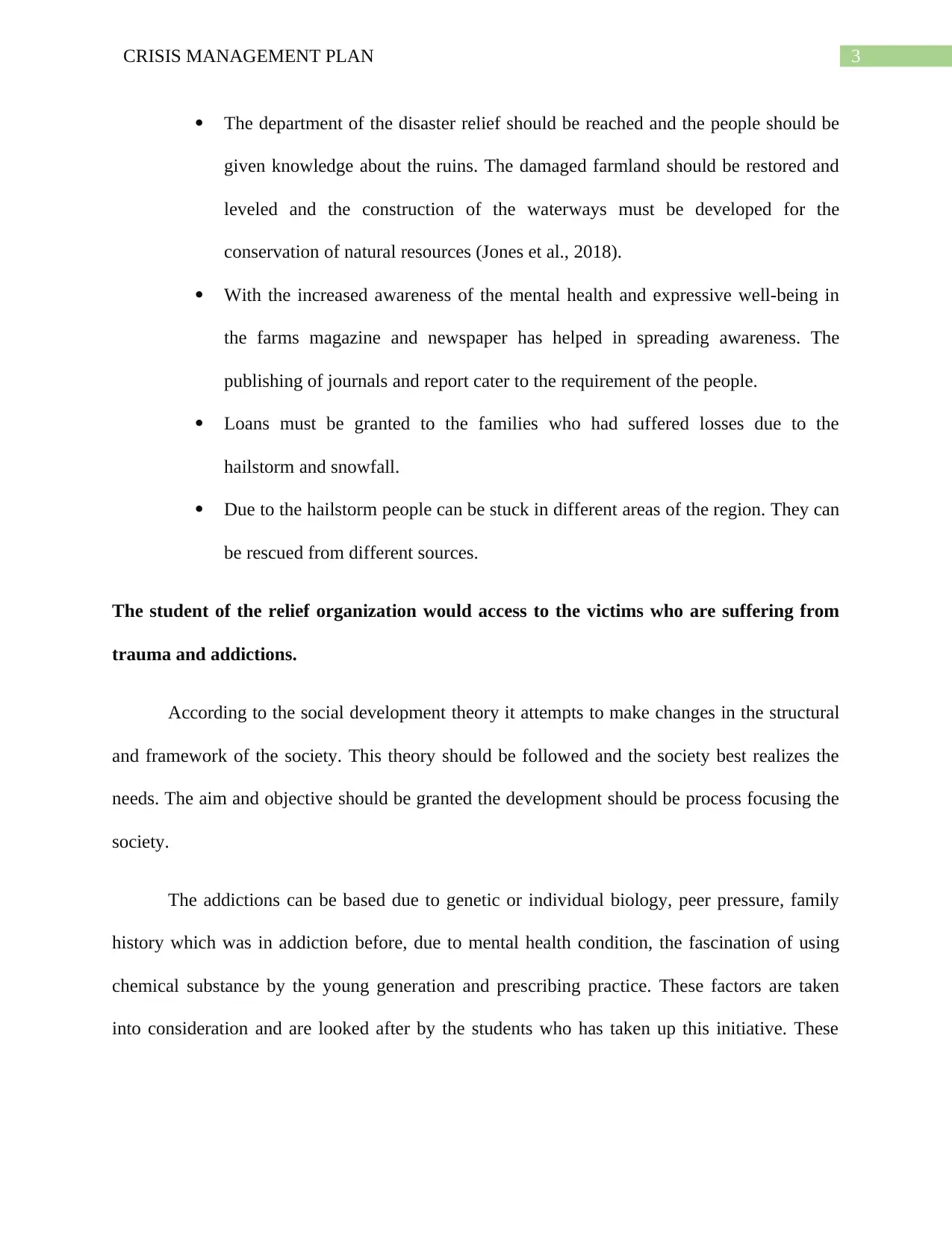
3CRISIS MANAGEMENT PLAN
The department of the disaster relief should be reached and the people should be
given knowledge about the ruins. The damaged farmland should be restored and
leveled and the construction of the waterways must be developed for the
conservation of natural resources (Jones et al., 2018).
With the increased awareness of the mental health and expressive well-being in
the farms magazine and newspaper has helped in spreading awareness. The
publishing of journals and report cater to the requirement of the people.
Loans must be granted to the families who had suffered losses due to the
hailstorm and snowfall.
Due to the hailstorm people can be stuck in different areas of the region. They can
be rescued from different sources.
The student of the relief organization would access to the victims who are suffering from
trauma and addictions.
According to the social development theory it attempts to make changes in the structural
and framework of the society. This theory should be followed and the society best realizes the
needs. The aim and objective should be granted the development should be process focusing the
society.
The addictions can be based due to genetic or individual biology, peer pressure, family
history which was in addiction before, due to mental health condition, the fascination of using
chemical substance by the young generation and prescribing practice. These factors are taken
into consideration and are looked after by the students who has taken up this initiative. These
The department of the disaster relief should be reached and the people should be
given knowledge about the ruins. The damaged farmland should be restored and
leveled and the construction of the waterways must be developed for the
conservation of natural resources (Jones et al., 2018).
With the increased awareness of the mental health and expressive well-being in
the farms magazine and newspaper has helped in spreading awareness. The
publishing of journals and report cater to the requirement of the people.
Loans must be granted to the families who had suffered losses due to the
hailstorm and snowfall.
Due to the hailstorm people can be stuck in different areas of the region. They can
be rescued from different sources.
The student of the relief organization would access to the victims who are suffering from
trauma and addictions.
According to the social development theory it attempts to make changes in the structural
and framework of the society. This theory should be followed and the society best realizes the
needs. The aim and objective should be granted the development should be process focusing the
society.
The addictions can be based due to genetic or individual biology, peer pressure, family
history which was in addiction before, due to mental health condition, the fascination of using
chemical substance by the young generation and prescribing practice. These factors are taken
into consideration and are looked after by the students who has taken up this initiative. These
Paraphrase This Document
Need a fresh take? Get an instant paraphrase of this document with our AI Paraphraser
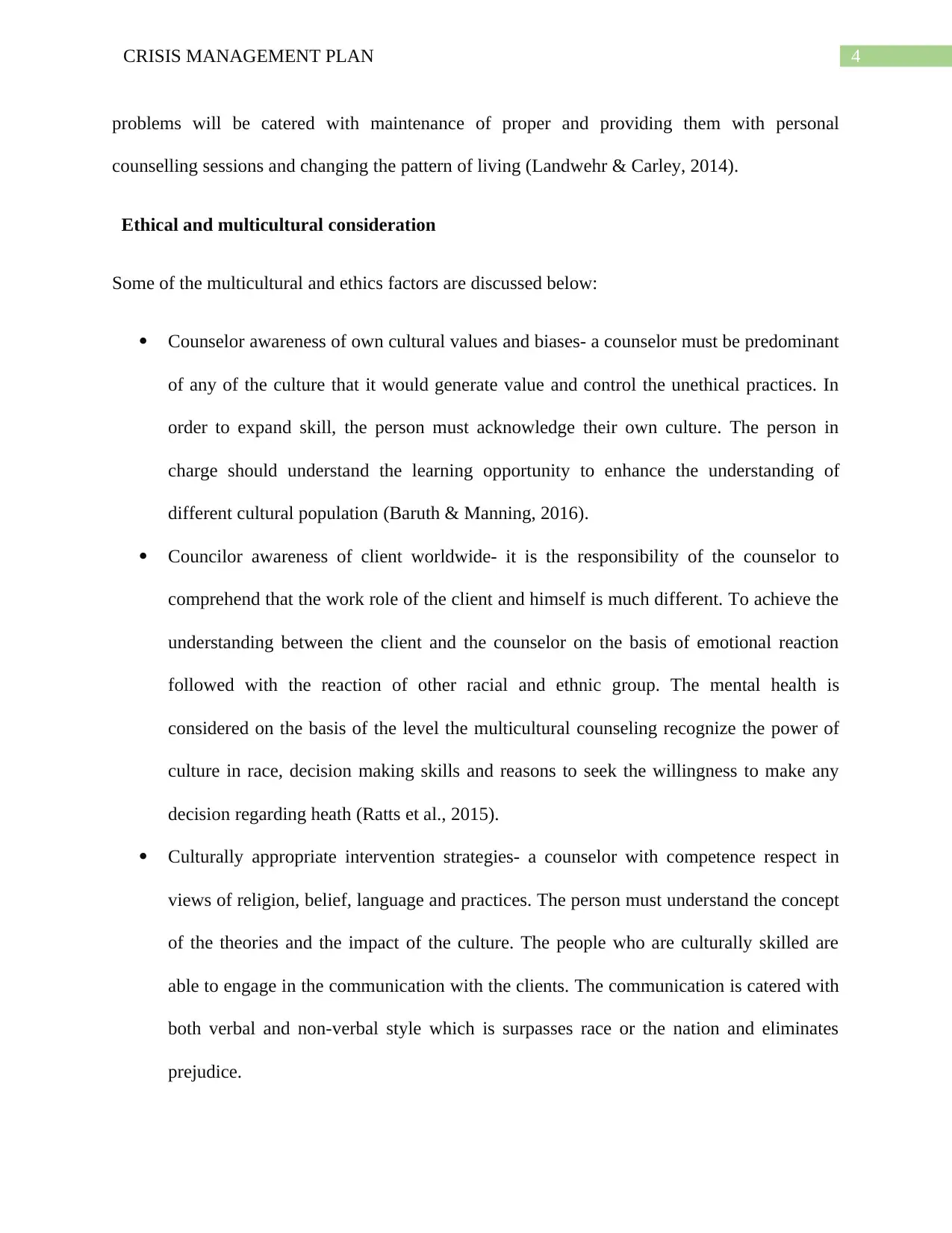
4CRISIS MANAGEMENT PLAN
problems will be catered with maintenance of proper and providing them with personal
counselling sessions and changing the pattern of living (Landwehr & Carley, 2014).
Ethical and multicultural consideration
Some of the multicultural and ethics factors are discussed below:
Counselor awareness of own cultural values and biases- a counselor must be predominant
of any of the culture that it would generate value and control the unethical practices. In
order to expand skill, the person must acknowledge their own culture. The person in
charge should understand the learning opportunity to enhance the understanding of
different cultural population (Baruth & Manning, 2016).
Councilor awareness of client worldwide- it is the responsibility of the counselor to
comprehend that the work role of the client and himself is much different. To achieve the
understanding between the client and the counselor on the basis of emotional reaction
followed with the reaction of other racial and ethnic group. The mental health is
considered on the basis of the level the multicultural counseling recognize the power of
culture in race, decision making skills and reasons to seek the willingness to make any
decision regarding heath (Ratts et al., 2015).
Culturally appropriate intervention strategies- a counselor with competence respect in
views of religion, belief, language and practices. The person must understand the concept
of the theories and the impact of the culture. The people who are culturally skilled are
able to engage in the communication with the clients. The communication is catered with
both verbal and non-verbal style which is surpasses race or the nation and eliminates
prejudice.
problems will be catered with maintenance of proper and providing them with personal
counselling sessions and changing the pattern of living (Landwehr & Carley, 2014).
Ethical and multicultural consideration
Some of the multicultural and ethics factors are discussed below:
Counselor awareness of own cultural values and biases- a counselor must be predominant
of any of the culture that it would generate value and control the unethical practices. In
order to expand skill, the person must acknowledge their own culture. The person in
charge should understand the learning opportunity to enhance the understanding of
different cultural population (Baruth & Manning, 2016).
Councilor awareness of client worldwide- it is the responsibility of the counselor to
comprehend that the work role of the client and himself is much different. To achieve the
understanding between the client and the counselor on the basis of emotional reaction
followed with the reaction of other racial and ethnic group. The mental health is
considered on the basis of the level the multicultural counseling recognize the power of
culture in race, decision making skills and reasons to seek the willingness to make any
decision regarding heath (Ratts et al., 2015).
Culturally appropriate intervention strategies- a counselor with competence respect in
views of religion, belief, language and practices. The person must understand the concept
of the theories and the impact of the culture. The people who are culturally skilled are
able to engage in the communication with the clients. The communication is catered with
both verbal and non-verbal style which is surpasses race or the nation and eliminates
prejudice.

5CRISIS MANAGEMENT PLAN
⊘ This is a preview!⊘
Do you want full access?
Subscribe today to unlock all pages.

Trusted by 1+ million students worldwide
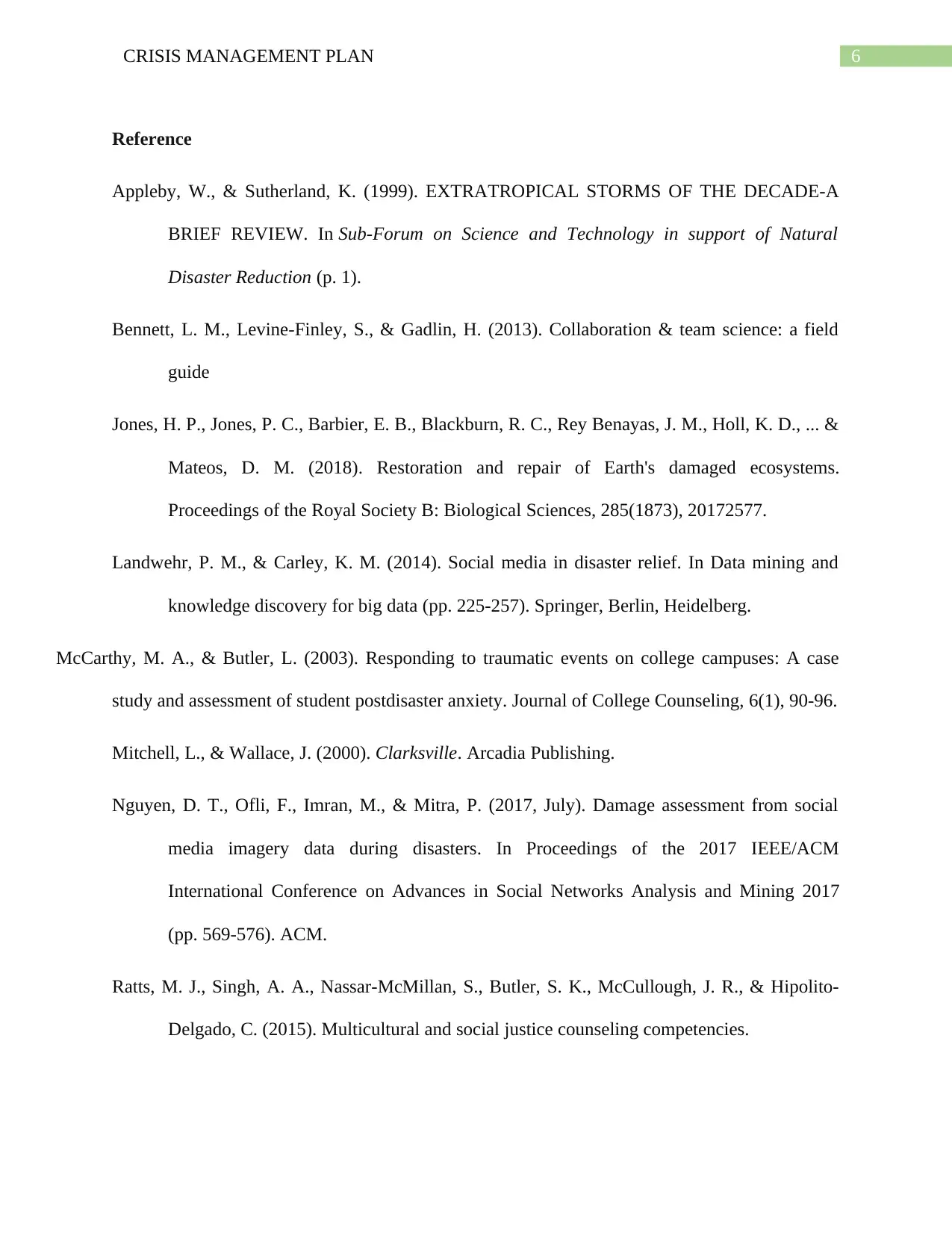
6CRISIS MANAGEMENT PLAN
Reference
Appleby, W., & Sutherland, K. (1999). EXTRATROPICAL STORMS OF THE DECADE-A
BRIEF REVIEW. In Sub-Forum on Science and Technology in support of Natural
Disaster Reduction (p. 1).
Bennett, L. M., Levine-Finley, S., & Gadlin, H. (2013). Collaboration & team science: a field
guide
Jones, H. P., Jones, P. C., Barbier, E. B., Blackburn, R. C., Rey Benayas, J. M., Holl, K. D., ... &
Mateos, D. M. (2018). Restoration and repair of Earth's damaged ecosystems.
Proceedings of the Royal Society B: Biological Sciences, 285(1873), 20172577.
Landwehr, P. M., & Carley, K. M. (2014). Social media in disaster relief. In Data mining and
knowledge discovery for big data (pp. 225-257). Springer, Berlin, Heidelberg.
McCarthy, M. A., & Butler, L. (2003). Responding to traumatic events on college campuses: A case
study and assessment of student postdisaster anxiety. Journal of College Counseling, 6(1), 90-96.
Mitchell, L., & Wallace, J. (2000). Clarksville. Arcadia Publishing.
Nguyen, D. T., Ofli, F., Imran, M., & Mitra, P. (2017, July). Damage assessment from social
media imagery data during disasters. In Proceedings of the 2017 IEEE/ACM
International Conference on Advances in Social Networks Analysis and Mining 2017
(pp. 569-576). ACM.
Ratts, M. J., Singh, A. A., Nassar-McMillan, S., Butler, S. K., McCullough, J. R., & Hipolito-
Delgado, C. (2015). Multicultural and social justice counseling competencies.
Reference
Appleby, W., & Sutherland, K. (1999). EXTRATROPICAL STORMS OF THE DECADE-A
BRIEF REVIEW. In Sub-Forum on Science and Technology in support of Natural
Disaster Reduction (p. 1).
Bennett, L. M., Levine-Finley, S., & Gadlin, H. (2013). Collaboration & team science: a field
guide
Jones, H. P., Jones, P. C., Barbier, E. B., Blackburn, R. C., Rey Benayas, J. M., Holl, K. D., ... &
Mateos, D. M. (2018). Restoration and repair of Earth's damaged ecosystems.
Proceedings of the Royal Society B: Biological Sciences, 285(1873), 20172577.
Landwehr, P. M., & Carley, K. M. (2014). Social media in disaster relief. In Data mining and
knowledge discovery for big data (pp. 225-257). Springer, Berlin, Heidelberg.
McCarthy, M. A., & Butler, L. (2003). Responding to traumatic events on college campuses: A case
study and assessment of student postdisaster anxiety. Journal of College Counseling, 6(1), 90-96.
Mitchell, L., & Wallace, J. (2000). Clarksville. Arcadia Publishing.
Nguyen, D. T., Ofli, F., Imran, M., & Mitra, P. (2017, July). Damage assessment from social
media imagery data during disasters. In Proceedings of the 2017 IEEE/ACM
International Conference on Advances in Social Networks Analysis and Mining 2017
(pp. 569-576). ACM.
Ratts, M. J., Singh, A. A., Nassar-McMillan, S., Butler, S. K., McCullough, J. R., & Hipolito-
Delgado, C. (2015). Multicultural and social justice counseling competencies.
Paraphrase This Document
Need a fresh take? Get an instant paraphrase of this document with our AI Paraphraser

7CRISIS MANAGEMENT PLAN
Suls, J., Rose, J. P., Windschitl, P. D., & Smith, A. R. (2013). Optimism following a tornado
disaster. Personality and social psychology bulletin, 39(5), 691-702.
Suls, J., Rose, J. P., Windschitl, P. D., & Smith, A. R. (2013). Optimism following a tornado
disaster. Personality and social psychology bulletin, 39(5), 691-702.
1 out of 8
Your All-in-One AI-Powered Toolkit for Academic Success.
+13062052269
info@desklib.com
Available 24*7 on WhatsApp / Email
![[object Object]](/_next/static/media/star-bottom.7253800d.svg)
Unlock your academic potential
Copyright © 2020–2025 A2Z Services. All Rights Reserved. Developed and managed by ZUCOL.
